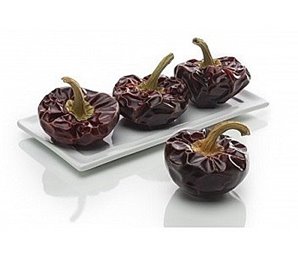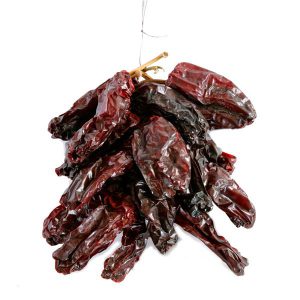
- Readers Rating
- No Rating Yet!
- Your Rating
In the rich and varied Spanish gastronomy, peppers play a fundamental role, providing colour, flavour and aroma to a wide variety of traditional dishes. Among the most emblematic and often confused are the ñora and the choricero pepper. Both are essential ingredients in many recipes, especially in the cuisines of the regions of Murcia and the Basque Country, respectively. Although at first glance they may appear similar, they have significant differences in terms of their origin, culinary use, and flavour profile. In this blog article, we will explore in depth the differences between the ñora and the choricero pepper, helping you to better understand these two jewels of Spanish cuisine.
1. Origin and cultivation
Ñora
The ñora is a small, rounded type of pepper grown mainly in the region of Murcia, in south-eastern Spain. Its origin dates back to the arrival of peppers in Europe after the discovery of America. The ñora is known for its intense red colour and its sweet, slightly smoky taste. This pepper is dried in the sun, which intensifies its flavour and makes it an indispensable ingredient in many Murcian dishes.
Choricero pepper
The choricero pepper, on the other hand, is an elongated, dried pepper grown mainly in the Basque Country and La Rioja. Like the ñora, the choricero pepper arrived in Spain from America, but adapted to the climatic and cultural conditions of the north of the country. This pepper is dried in strings and is known for its sweet taste and its ability to bring a vibrant red colour to dishes.
2. Appearance and taste
Ñora
One of the main differences between the ñora and the chorizo pepper is the appearance and taste. The ñoras are small, round and have a dark red colour when dry. Their skin is thick and their flesh is fleshy. The flavour of the ñora is sweet, with a smoky, earthy touch, making them ideal for adding depth of flavour to stews, sauces and rice dishes.
Choricero pepper
Choricero peppers are elongated and larger than ñoras. Their colour is also deep red, but their shape is significantly different. The taste of the choricero pepper is equally sweet, but with a less smoky and more vegetal profile. It is especially known for its use in the preparation of chorizo, hence its name.

3. Culinary uses
Ñora
The ñora is mainly used in Murcian and Levantine cuisine. One of the most famous dishes using ñoras is Caldero, a fish and rice stew typical of the region of Murcia. The ñoras are also used in the preparation of caldero sauce and in arroz a banda, where they add a deep flavour and colour to the fish broth.
To use the ñora, it is usually first hydrated in hot water for about 15-20 minutes. Then they are opened and the pulp is scraped out with a knife, discarding the seeds and skin. This pulp is added to recipes to enhance their flavour.
Choricero pepper
The choricero pepper is a fundamental ingredient in the cuisine of northern Spain, especially in the preparation of sauces and sausages. One of the most emblematic uses is in salsa vizcaína, a red sauce that accompanies bacalao a la vizcaína. Like the ñoras, the choricero peppers are hydrated before use and their pulp is extracted.
Choricero peppers are also a key ingredient in the preparation of chorizo, providing its characteristic red colour and a sweet flavour that balances the spices of the sausage. It is also used in the preparation of stews and casseroles, such as Rioja-style potatoes.
4. Drying and preservation process
Ñora
The drying of the ‘ñora’ is a traditional process carried out in the sun. The peppers are harvested at their optimum point of ripeness and are left to dry on large surfaces in the open air. This drying method allows the ñora to develop its characteristic flavour, concentrating its natural sugars and adding a smoky touch. Once dried, the peppers can be kept for several months in a cool, dry place.
Choricero pepper
The choricero pepper is dried in strings, a method that consists of stringing the peppers on a string and hanging them in a dry and well-ventilated place. This process can take several weeks and allows the peppers to dehydrate slowly, maintaining their flavour and colour. Dried choricero peppers can also be stored for long periods, which makes them very practical for cooking.
5. Nutrition and health benefits
Ñora
Another difference between the ñora and the chorizo pepper is that the former are rich in vitamins A and C, as well as antioxidants. These nutrients are essential for eye health, the immune system and protection against free radicals. In addition, their fibre content aids digestion and their sweet taste can help reduce the need to add sugar to recipes.
Choricero pepper
Chilli peppers are also an excellent source of vitamins A and C, and contain antioxidant compounds that can help fight inflammation and promote cardiovascular health. Their regular consumption can contribute to a balanced and healthy diet, especially when used to enhance the flavour of nutritious dishes without adding excess fat or salt.
Buy choricero pepper at mentta

6. Substitutions and alternatives
In some recipes, you may not have access to chilli peppers or ñoras. In these cases, there are some alternatives you can consider.
Substitutions for Ñora:
- Ancho pepper: This dried Mexican pepper has a similar sweet, smoky flavour and can be a good alternative in stews and sauces.
- Piquillo pepper: Although not dried, the piquillo pepper has a sweet taste and can be used as a substitute in some recipes, although the result will not be exactly the same.
Substitutions for Choricero pepper:
- Red pepper: In some cases, you can use fresh red peppers that you can then roast and partially dehydrate to mimic the flavour of the choricero pepper.
- Paprika: If you need the flavour and colour, a mixture of sweet paprika and smoked paprika can be an alternative, although it will lack the texture and complexity of the chorizo pepper.
7. Recipes
Recipe with Ñora: Caldero Murciano (Murcian Stew)
Ingredients:
- 1 kg of fish (gilthead bream, mullet or similar)
- 4 ñoras (black peppers)
- 4 cloves of garlic
- 1 onion
- 2 ripe tomatoes
- 400 g of rice
- 1 litre of fish fumet
- Extra virgin olive oil
- Salt and pepper to taste
Instructions:
- Hydrate the peppers in hot water for 20 minutes. Then remove the pulp.
- In a casserole, heat the olive oil and fry the chopped garlic and onion.
- Add the grated tomatoes and the pulp of the ñoras. Cook over a low heat.
- Add the fish stock and bring to the boil.
- Add the rice and cook until it is cooked.
- In the last few minutes, add the fish and cook until done.
- Adjust salt and pepper and serve hot.
Recipe with Chorizo Peppers: Cod Vizcaína Style
Ingredients:
- 800 g of desalted cod
- 4 choricero peppers
- 2 large onions
- 3 cloves of garlic
- 4 ripe tomatoes
- Extra virgin olive oil
- Salt to taste
Instructions:
- Hydrate the peppers in hot water and remove the pulp.
- Heat the olive oil in a casserole and fry the chopped onions and garlic.
- Add the grated tomatoes and cook over a low heat.
- Add the flesh of the peppers and cook for a few more minutes.
- Add the cod and simmer until done.
- Adjust the salt and serve hot with the vizcaína sauce on top.
These ingredients, although often confused, have their own unique flavour profiles and culinary applications. Knowing the differences between the ñora and the choricero pepper will not only help you choose the right one for your recipes, but will also allow you to appreciate the richness and diversity of Spanish cuisine. From Murcian stews to Basque sausages, both peppers play a crucial role in creating authentic and delicious flavours that have been appreciated for generations. Visit mentta’s blog and find out more about gastronomy.
